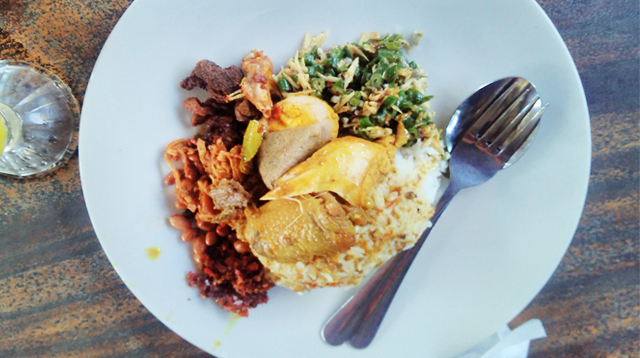THE ISLAND of the Gods does only offer beautiful beaches and exotic culture, but also an extraordinary culinary richness. Among other iconic dishes, Balinese Mixed Rice stands as a perfect representation of the philosophy of Balinese cuisine: a harmonious blend of complex spices and a variety of side dishes in one complete dish.
What is Mixed Rice?
Literally, mixed rice means “rice mixed” with various side dishes. This dish is a very popular staple and is easily found throughout Indonesia, but each region has its own unique characteristics.
In Bali, mixed rice is more than just a side dish; it is a cultural canvas that brings together savory, spicy, sweet, and aromatic flavors on one plate. An authentic portion of Balinese mixed rice is served with white rice in the center, surrounded by small pieces of colorful and flavorful Balinese side dishes, often enhanced by a thick yellow sauce.
A Brief History of Mixed Rice
The origins of mixed rice cannot generally be traced to a single recipe. This dish is believed to have evolved from the traditional Indonesian dining habit of serving a variety of side dishes (lauk-pauk) in the center of the table to be enjoyed with rice. The concept is efficiency and nutritional completeness in one bite.
In Bali, mixed rice grew out of a local culinary tradition heavily influenced by Base Genep—a complete Balinese spice base consisting of more than 15 spices, such as shallots, garlic, chilies, ginger, turmeric, galangal, lemongrass, lime leaves, and shrimp paste. This Base Genep gives each side dish a unique soul and character, distinguishing it from mixed rice variants found in Java or Sumatra. Legendary stalls selling mixed rice in Bali, such as those that have been around since the 1970s, demonstrate that this dish has been an integral part of Balinese breakfast and lunch for decades.
Key Components of Balinese Mixed Rice
The strength of Balinese mixed rice lies in its rich and boldly spiced side dishes. The fillings can vary depending on the vendor, but here are a few must-haves:
Balinese Spiced Shredded Chicken (Ayam Pelalah/Sisit): Boiled, shredded chicken breast cooked in a thick red sauce that’s spicy, savory, and slightly sour from lime juice.
Sate Lilit: A Balinese satay made from minced meat (fish, chicken, or pork) mixed with grated coconut and Base Genep, then wrapped around lemongrass stalks or bamboo and grilled. The fragrant aroma of lemongrass is its signature dish.
Lawar: A mixture of vegetables (usually long beans), grated coconut, Base Genep, and sometimes minced meat. Lawar offers a crunchy texture and complex spice flavor, serving as a refreshing balance.
Sambal Matah: Bali’s iconic raw sambal made from thinly sliced shallots, bird’s eye chilies, lemongrass, lime leaves, shrimp paste, and hot coconut oil. The fresh, spicy, and fragrant flavor of this sambal is the lifeblood of mixed rice.
Other Accompaniments: Often served with sliced suckling pig (for the non-halal version), boiled egg, fried tempeh or tofu, and of course, crispy chicken skin or fried peanuts for a crunchy sensation.
Culinary Tourism Attractions
Bali’s Mixed Rice is more than just fast food, but a cultural experience sought after by tourists:
Gateway to Flavor: Mixed rice offers a “complete package” of Balinese cuisine. In one plate, tourists can sample almost all of Bali’s spices and side dishes without having to order separate main dishes.
Authenticity of Traditional Warungs: Tourists often seek out mixed rice at legendary, humble stalls. Interacting at roadside stalls or traditional markets offers a more authentic experience and a closer connection to local life.
A Tempting Spicy Sensation: The spiciness of the shredded chicken and the freshness of the Sambal Matah (Indonesian Sambal Matah) offer both a challenge and a delight for adventurous culinary enthusiasts.
In short, eating Balinese Mixed Rice is the quickest and easiest way to explore the culinary riches of the Island of the Gods, making it a must-have for any culinary traveler.










